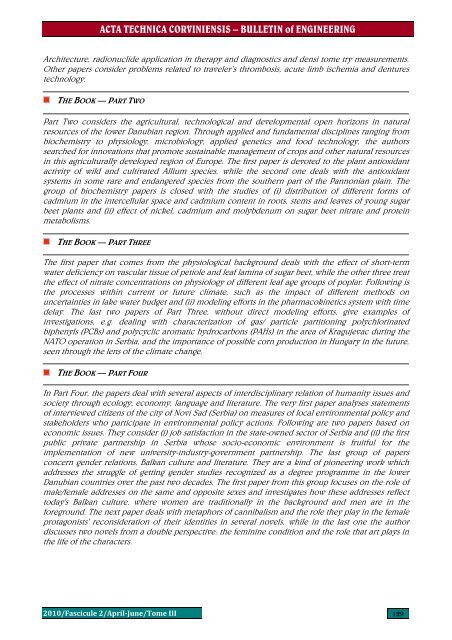ACTA TECHNICA CORVINIENSIS - Bulletin of Engineering
ACTA TECHNICA CORVINIENSIS - Bulletin of Engineering
ACTA TECHNICA CORVINIENSIS - Bulletin of Engineering
- No tags were found...
Create successful ePaper yourself
Turn your PDF publications into a flip-book with our unique Google optimized e-Paper software.
<strong>ACTA</strong> <strong>TECHNICA</strong> <strong>CORVINIENSIS</strong> – BULLETIN <strong>of</strong> ENGINEERINGArchitecture, radionuclide application in therapy and diagnostics and densi tome try measurements.Other papers consider problems related to traveler’s thrombosis, acute limb ischemia and denturestechnology.THE BOOK — PART TWOPart Two considers the agricultural, technological and developmental open horizons in naturalresources <strong>of</strong> the lower Danubian region. Through applied and fundamental disciplines ranging frombiochemistry to physiology, microbiology, applied genetics and food technology, the authorssearched for innovations that promote sustainable management <strong>of</strong> crops and other natural resourcesin this agriculturally developed region <strong>of</strong> Europe. The first paper is devoted to the plant antioxidantactivity <strong>of</strong> wild and cultivated Allium species, while the second one deals with the antioxidantsystems in some rare and endangered species from the southern part <strong>of</strong> the Pannonian plain. Thegroup <strong>of</strong> biochemistry papers is closed with the studies <strong>of</strong> (i) distribution <strong>of</strong> different forms <strong>of</strong>cadmium in the intercellular space and cadmium content in roots, stems and leaves <strong>of</strong> young sugarbeet plants and (ii) effect <strong>of</strong> nickel, cadmium and molybdenum on sugar beet nitrate and proteinmetabolisms.THE BOOK — PART THREEThe first paper that comes from the physiological background deals with the effect <strong>of</strong> short-termwater deficiency on vascular tissue <strong>of</strong> petiole and leaf lamina <strong>of</strong> sugar beet, while the other three treatthe effect <strong>of</strong> nitrate concentrations on physiology <strong>of</strong> different leaf age groups <strong>of</strong> poplar. Following isthe processes within current or future climate, such as the impact <strong>of</strong> different methods onuncertainties in lake water budget and (ii) modeling efforts in the pharmacokinetics system with timedelay. The last two papers <strong>of</strong> Part Three, without direct modeling efforts, give examples <strong>of</strong>investigations, e.g. dealing with characterization <strong>of</strong> gas/ particle partitioning polychlorinatedbiphenyls (PCBs) and polycyclic aromatic hydrocarbons (PAHs) in the area <strong>of</strong> Kragujevac during theNATO operation in Serbia, and the importance <strong>of</strong> possible corn production in Hungary in the future,seen through the lens <strong>of</strong> the climate change.THE BOOK — PART FOURIn Part Four, the papers deal with several aspects <strong>of</strong> interdisciplinary relation <strong>of</strong> humanity issues andsociety through ecology, economy, language and literature. The very first paper analyses statements<strong>of</strong> interviewed citizens <strong>of</strong> the city <strong>of</strong> Novi Sad (Serbia) on measures <strong>of</strong> local environmental policy andstakeholders who participate in environmental policy actions. Following are two papers based oneconomic issues. They consider (i) job satisfaction in the state-owned sector <strong>of</strong> Serbia and (ii) the firstpublic private partnership in Serbia whose socio-economic environment is fruitful for theimplementation <strong>of</strong> new university-industry-government partnership. The last group <strong>of</strong> papersconcern gender relations, Balkan culture and literature. They are a kind <strong>of</strong> pioneering work whichaddresses the struggle <strong>of</strong> getting gender studies recognized as a degree programme in the lowerDanubian countries over the past two decades. The first paper from this group focuses on the role <strong>of</strong>male/female addresses on the same and opposite sexes and investigates how these addresses reflecttoday's Balkan culture, where women are traditionally in the background and men are in theforeground. The next paper deals with metaphors <strong>of</strong> cannibalism and the role they play in the femaleprotagonists' reconsideration <strong>of</strong> their identities in several novels, while in the last one the authordiscusses two novels from a double perspective: the feminine condition and the role that art plays inthe life <strong>of</strong> the characters.2010/Fascicule 2/AprilJune/Tome III 129
















